| Image |
Type |
Built |
Qty |
Used |
Added |
Edited |
|
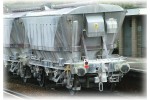 |
CBA/CDA/PGA Hoppers (MGR derivatives)  |
1969-1989 |
235 |
1969-current |
22/12/2007 |
21/05/2008 |
|
Three batches of wagons have been built whose design derived from the hugely successful Merry-go-round coal hopper type. Separated by nearly 15 years, the designs were for three different commodities (lime, gypsum and china clay) and served specific flows in almost geographically opposite corners of the country. The gypsum hoppers were sold to the private sector before entering service while the limestone wagons diversified into potash before succumbing to corrosion. Only the china clay wagons, built in the 1980s, survive.
|
|
 |
HAA 'Merry-go-round' Coal Hoppers |
1964-1977 |
11162 |
1964-current |
1/12/2006 |
24/12/2006 |
|
The HAA wagon (and its derivatives) was part of a drive to improve the efficiency of the movement of coal to power stations. They became the most numerous air-braked wagon type, and quietly went about their business until they were eventually displaced by the closure of many collieries and the introduction of new wagon designs. Although large quantites were scrapped, many lived on, having been rebuilt as box wagons for carrying ballast.
|
|
 |
HBA/HEA Hoppers  |
1975-1979 |
1999 |
1975-current |
16/12/2007 |
16/12/2007 |
|
Just under 2000 HBAs were built in the 1970s and were intended to become the standard general-purpose hopper wagon. Within a few years they were recoded as HEAs with improved suspension. However, declining traffic has seen the fleet undergo numerous modifications and rebuilds.
|
|
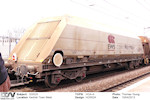 |
HOA/IIA Bogie Aggregate/Sand Hoppers |
2006-2009 |
162 |
2006-current |
15/10/2014 |
10/05/2015 |
|
Almost from the start, EWS had ambitious plans to build many new wagons. However, its first order for aggregate hoppers was not placed until 2005, these becoming the HOA class. Delivered in EWS livery, many of the wagons were very soon repainted into the colours of their main user. A follow-on batch also wore this livery but were from a different builder and carrying 'international' numbers. More wagons to the latter design were ordered for use by Mendip Rail.
|
|
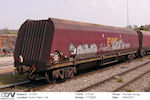 |
HTA Bogie Coal Hoppers |
2001-2004 |
1144 |
2001-current |
01/12/2006 |
16/03/2010 |
|
Soon after it was formed, EWS announced it was to buy a large number of new high-capacity wagons. One of the types indentified for replacement was the HAA merry-go-round coal hopper, all of which were between 18 and 36 years old. The design selected became the HTA, and a total of 1144 were built at the reopened York works between 2001 and 2004.
|
|
 |
HTO/HTV 21t Coal Hoppers |
1949-1959 |
23150 |
1949-1991 |
15/12/2007 |
02/07/2008 |
|
The 21ton steel-bodied coal hopper was based on an LNER design and was the standard BR coal hopper until the advent of air-braked types in the 1960s and 1970s. Over 23,000 wagons were built, making them one of the most numerous types on BR and, although seen in many places, they were most at home in the coalfields of North East England. Most of the wagons were rebodied at least once, to a simplified design with fewer ribs, while over a third of the fleet eventually gained vacuum brakes. Coded HTO and HTV under TOPS, the wagons were never fully replaced by air braked wagons but colliery closures had a major impact on their numbers. The unfitted fleet was eradicated by the mid 1980s while just a handful of HTVs made it into the 1990s. Many of the wagons survived longer, at least in part, with their underframes receiving new box bodies for the departmental fleet.
|
|
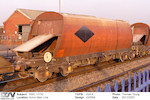 |
JGA RMC Bogie Stone Hoppers  |
1984-1997 |
89 |
1984-current |
01/10/2007 |
10/05/2015 |
|
The fleet of bogie hoppers used by Ready Mixed Concrete (RMC) wear a distinctive bright orange livery and until 2007 could be seen running in block formations carrying limestone from the quarry at Peak Forest near Buxton. The total of 89 wagons covers four batches built to three main designs over a period of 13 years, and trains often featured several or all of the variants. More recently the wagons have been in general use with EWS in the South East.
|
|
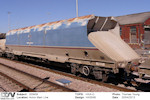 |
National Power JHA/JMA Hoppers (later HJA/HKA) |
1993-1995 |
106 |
1994-current |
15/10/2014 |
15/10/2014 |
|
In the mid-1990s, electricity generator National Power joined the small club of companies that ran their railfreight services using their own locomotives. Six class 59 locos and two batches of hoppers (totalling 106 wagons) carried a distinctive blue and grey livery on services centred on the giant Drax power station. The operation was short-lived, being sold to EWS in 1998. The rolling stock has seen more widespread usage under its new ownership, with many of the wagons being rebogied and renumbered.
|
|
 |
PG010 Hoppers |
1975 |
115 |
1975-current |
1/12/2006 |
24/12/2006 |
|
This batch of wagons was built to convey limestone from the quarry at Redmire in North Yorkshire to the British Steel works at Redcar, Cleveland. They were notable for having automatic door control equipment similar to that fitted to MGR coal hoppers, and tall bodies with a narrow top opening. Although the ownership of the wagons (and the quarries that the services work from) has changed in recent years, most still serve the Teesside steel industry. Some surplus wagons were rebuilt as general purpose hoppers but these saw very limited use and were soon withdrawn.
|
|
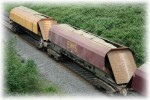 |
PHA/JHA/HLA Marcon Bogie Gravel Hoppers |
1969-1991 |
35 |
1969-current |
1/12/2006 |
24/12/2006 |
|
For a small fleet seen in a limited area this group of wagons has had a fairly interesting time, although I am perhaps biased as they are the only type I see on a regular basis. Three batches were built, with two types of bogies and several other design differences. Over the years, four liveries have been carried, and all the wagons were eventually rebodied and modified to have a more uniform appearance. Throughout this time the wagons worked in bloack formations carrying sea-dredged gravel from terminals on the River Thames to various locations around London.
|
|
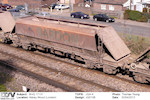 |
PHA/JGA Bardon Bogie Aggregate Hoppers  |
1986-2004 |
73 |
1986-current |
23/12/2007 |
10/05/2015 |
|
Bardon Hill Quarries (later renamed Bardon Aggregates) bought four batches of bogie hoppers between 1986 and 2004, totalling 73 wagons. They have been used in block formations between the quarries in Leicestershire and various terminals in the southeast of England.
|
|
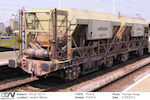 |
Redland Self-Discharge Trains  |
1988-1990 |
124 |
1988-current |
01/01/2008 |
17/05/2008 |
|
The Self-Discharge Trains operated by Redland (later Lafarge) were an attempt to combine the rapid unloading characteristics of hopper wagons with the operational flexibility of open wagons that required no specialised unloading equipment. This is achieved by use of a conveyor built into the bottom of each set of wagons and an unloading vehicle coupled at one end. Despite the mechanical complexity of the concept it appears to have been successful with several sets built for use both in the UK and abroad.
|
|
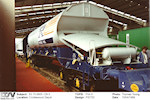 |
PIA/KPA Tiphook Hoppers and HQA/JJA Autoballasters |
1988-2006 |
400 |
1988-current |
20/10/2008 |
01/05/2013 |
|
Wagon hirer Tiphook bought 150 bogie hoppers in the late 1980s for spot-hires in various traffics. Within a few years most were stored out of use and one was modified as a ballast hopper with a view to replacing railway-owned types such as the Walrus and Sealion. The conversion, dubbed Autoballaster, was evidently a success and further batches accounted for the majority of the stored wagons. There was then a programme of building new Autoballasters with an order for 190 wagons followed by further batches of 50 and 10.
|
|
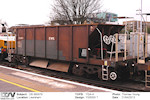 |
YGB Seacow / YGH Sealion / YGV Walrus
40t Bogie Ballast Hoppers |
1954-1982 |
789 |
1954-current |
1/12/2006 |
24/12/2006 |
|
Although seemingly built over an extended period, the basis of this type was actually a design by the London and South Western Railway first introduced in 1903. Apart from the bogies there were only very minor changes between the oldest and the newest builds, a testimony to the soundness of the original design. Most of the examples built in the 1970s and 1980s remain in service today, working alongside newer autoballasters and a growing number of box wagons.
|
|
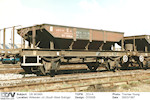 |
ZEV 'Catfish'/ZFV 'Dogfish' Ballast Hoppers  |
1953-1961 |
1959 |
1953-2007 |
30/03/2008 |
05/04/2008 |
|
The Catfish and Dogfish were BRís standard small ballast hopper wagons, almost 2000 being built. Fitted with vacuum brakes from new, many lasted into the 1990s while a programme to fit air-brakes to surviving Dogfish wagons was started in 2000. Despite this, the last examples of both types were withdrawn in 2006.
|
|




















